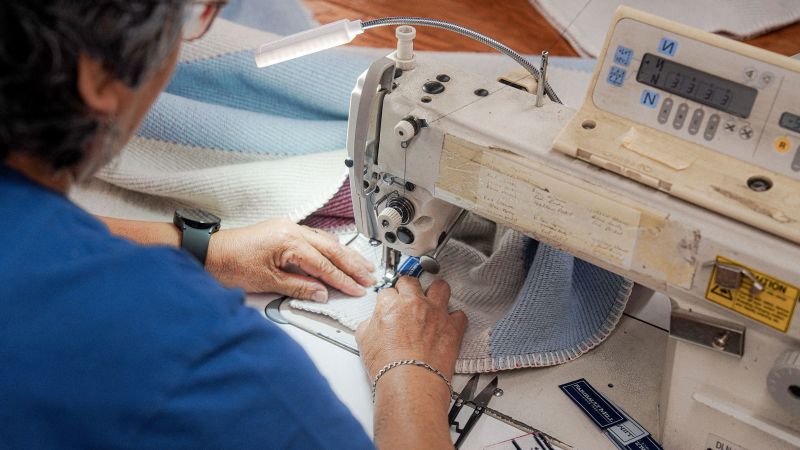The journey of wool transforming into a classic Faribault Mill blanket is a meticulous process involving approximately 20 steps, all contained within a single facility located in the southern region of Minnesota. This operation is not merely an assembly line; it showcases a harmonious blend of cutting-edge technology and historical machinery, reflecting 160 years of craftsmanship. Employees, many of whom are third and fourth-generation workers at the mill, contribute to this intricate operation, preserving the legacy while embracing modern advancements.
One notable aspect of this production is the absence of the raw material’s source within the vicinity. The sheep from which the wool originates are often roaming freely, grazing in the expansive fields of the Rocky Mountains, several states away. Despite its physical distance from the livestock, the Faribault Mill has maintained a steady workflow, a feat that has become increasingly rare among U.S. companies grappling with volatile economic conditions. President Donald Trump’s implementation of significant tariffs has disrupted various businesses reliant on international trade; however, the Faribault Mill has managed to remain resilient amidst these challenges.
Ross Widmoyer, the CEO of Faribault Mill, expressed confidence in their operational strategy, noting, “We haven’t had to create a war room; we’ve just continued to make blankets the way we’ve been doing it for a long time.” As demand surges, especially with retailers preparing for seasonal peaks during fall and Christmas, the mill’s productivity appears to be thriving rather than faltering, even amidst tariff concerns. He shared that the uptick in inquiries from potential new customers is a promising sign of the mill’s reputation for quality and reliability.
Yet, underlying this optimism is the acknowledgment that no company operates in a vacuum of certainty. Widmoyer pointed out that issues pertaining to tariffs and potential declines in consumer spending could impact all businesses, regardless of their supply chain’s domestic focus. The unpredictability stemming from the economic landscape causes inherent trepidations — a worry that resonates beyond the walls of the mill to various sectors within the industry.
On a broader scale, the U.S. pet toy market faces similar challenges. Approximately $723 million worth of pet toys were imported last year, with a staggering 93% of those items sourced from China. Companies like West Paw, situated in picturesque Bozeman, Montana, stand to benefit from recent tariffs that may shield them from international competition, particularly as they have cultivated domestic supply chains focused on sustainability and community vitality. The founder and CEO, Spencer Williams, articulated a forward-looking mindset, stating, “We will take on, happily, a partnership with a retailer who’s looking for a long-term relationship.”
However, the 2025 horizon may not replicate the peaks experienced during the pandemic due to several factors, including uncertainty about the permanence of current tariffs and concerns regarding retaliatory actions from other countries that could impact their export business — a notable venture comprising 15% to 18% of their total revenue. Williams stressed cautious optimism, indicating that while their business thrives on meeting immediate needs, they remain mindful of the broader implications of trade dynamics, particularly as they export to 40 nations.
The manufacturing landscape in the United States has witnessed both challenges and opportunities. For instance, Sherrill Manufacturing emerged from the closure of Oneida Limited’s factory in New York, reviving local production and establishing itself as the sole remaining flatware maker in the nation. Co-founder Greg Owens sees a renaissance for domestic manufacturing on the horizon, contingent upon the continued implementation of tariffs. There’s a sense of anticipation present among manufacturers, as many await final decisions on policies that could enable them to plan for growth and investment.
While Sherrill Manufacturing has the facility capacity to expand significantly, not all sectors exhibit the same level of preparedness. The uncertainty remains palpable, and the call for more predictable regulatory environments is echoed by others, including Widmoyer at Faribault Mill. The manufacturing sector’s ability to adapt and survive may hinge on how well businesses respond to challenges while nurturing relationships with consumers and playing an integral role within the economy.
Ultimately, the ability of these American manufacturers to thrive amid tariffs, evolving consumer behaviors, and geopolitical intricacies is not solely dictated by their domestic strategies. Companies must balance the duality of competition with imports while also recognizing the importance of existing global partnerships. Adaptability, foresight, and a commitment to community and environmental sustainability will likely serve as critical tenets guiding the future of industries entrenched in this complex economic landscape.



